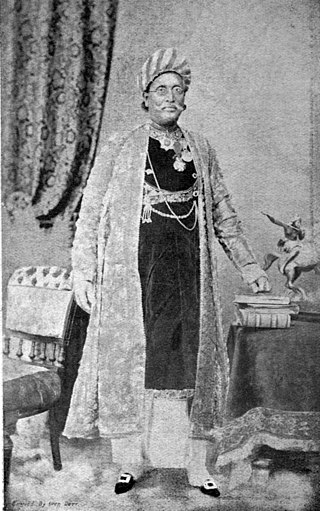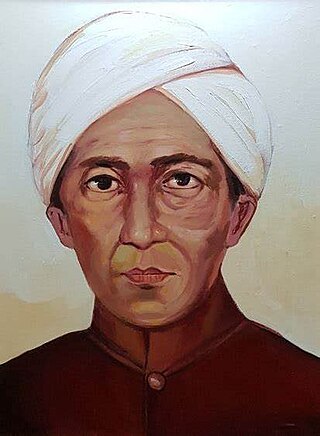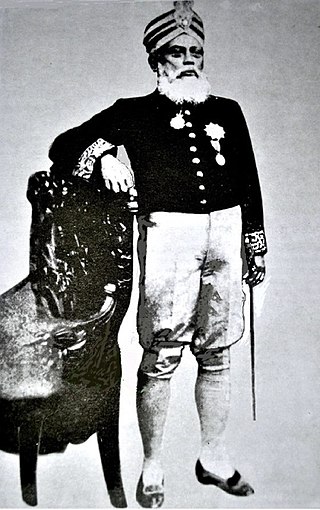Related Research Articles

Syed Nazrul Islam was a Bangladeshi politician and a senior leader of the Awami League. During the Bangladesh Liberation War, he was declared as the Vice President of Bangladesh by the Provisional Government. He served as the Acting President in the absence of Sheikh Mujibur Rahman.

Nawab Bahadur QaziAbdul Latif was a Bengali Muslim aristocrat, educator and social worker. His title, Nawab was awarded by the British in 1880. He was one of the first Muslims in 19th-century India to embrace the idea of modernisation.

Haji Muhammad Mohsin was a prominent Bengali Muslim philanthropist. His most notable contribution was to establish the Hooghly Mohsin College and the Hooghly Imambara. He also played a significant role during the Great Bengal famine of 1770 by helping thousands of the victims.

Government Brajalal College, also known as BL College, is one of the oldest institutions of higher education in Bangladesh. It is located in Khulna, a major metropolis of the country.

Abdul Mannan Syed was a Bangladeshi poet, and critic. He is known for his considerable research works on Kazi Nazrul Islam, Jibanananda Das, Farrukh Ahmad, Syed Waliullah, Manik Bandyopadhyay, Bishnu De, Samar Sen, Roquiah Sakhawat Hossain, Abdul Ghani Hazari, Muhammad Wajed Ali, Prabodh Chandra Sen. From 2002 to 2004, he held the position of Executive Director of Nazrul Institute.

Dhaka Government Muslim High School is a secondary school in Lakshmi Bazaar in Dhaka, Bangladesh. It is one of the oldest schools in Dhaka.

Kabi Nazrul Government College (KNGC) is a governmental college located in Luxmibazar, Dhaka, the capital of Bangladesh. It was formerly known as Govt. Kabi Nazrul College.

Ubaidullah Al Ubaidi Suhrawardy was a Bengali Islamic scholar, educationist and writer from Midnapore. He is regarded as the Father of modern Islamic education in Bengal and was awarded with the title of Bahr ul Ulum, meaning: sea of knowledge by the British.

Hooghly Imambara is a Shia Muslim congregation hall and mosque in Hooghly, West Bengal, India. The construction of the building was started by Muhammad Mohsin in 1841 and completed in 1861. The building is a two storied structure, with a tall clock tower over the entrance gate. The mosque has intricate designs and texts from Quran engraved on the wall. The interior of the mosque is decorated with marbles, candles and hanging lanterns.

Sir Syed Shamsul Huda (1862–1922) was a Muslim political leader of the Bengal Executive Council. He became the first British Indian Muslim President of the Legislative council in 1921. Huda was born in Gokarna, palace known as Gokarna Nawab Bari Complex Nasirnager, Brahmanbaria. It was the part of Cumilla. Earlier known as greater Hill Tipperah. His father Syed Riazat Ullah was the editor of The Doorbeen, a Persian weekly journal.

Shia Muslims are a minority in Bangladesh, with roughly 2% of the population being Shia. Many Bangladeshi Shi'a Muslims belong to the Bihari community. Even though there are only small numbers of Shi'as, the observance commemorating the martyrdom of Ali's sons, Hasan and Husayn, are still widely observed by the nation's Sunni community; highlighting the historical influence that the Shi'ites had in Bengal.
Dhaka Mussalman Suhrid Sammilani was a reformist organization of Muslims based in Dhaka during the late 19th century.
Hooghly Madrasah is one of the oldest educational institute in West Bengal. It was established by a renowned philanthropist of Bengal, Haji Muhammad Mohsin.

Moḥammad Abū Bakr Ṣiddīque was a Bengali Islamic scholar and the inaugural Pir of Furfura Sharif in West Bengal. He is regarded by his followers, who are scattered across eastern India and Bangladesh, as a mujaddid (reviver) of Islam in the region, due to his significant contributions in religious propagation via the establishment of mosques and madrasas, publication of newspapers and education development in neglected areas. He was the founding president of the sociopolitical Anjuman-i-Wazin-i-Bangla organisation, which advocated for causes such as the Khilafat Movement and Pakistan Movement. Siddique died in 1943, and his shrine is greatly venerated as one of West Bengal's most prominent Sufi centres.
Majd ad-Dīn al-Madanī, also known as Madan Shāhjahānpūrī, was an 18th-century Indian Muslim theologian. He served as the first principal of the Calcutta Madrasa, the first Alia Madrasa of Bengal.

The zamindars of Mahipur were a Bengali aristocratic family of feudal landowners. The zamindari estate encompassed the Chakla of Qazirhat under the Cooch Behar State since the Mughal period. Although their aristocratic status was lost with the East Bengal State Acquisition and Tenancy Act of 1950, the Mahipur estate remains an important part of the history of Rangpur and belongs to one of the eighteen ancient zamindar families of Rangpur. The zamindari palace was lost as a result of flooding from the Teesta River, although the mosque, cemetery, polished reservoir and large draw-well can still be seen today.

Nesaruddin Ahmad was a Bengali Islamic scholar, spiritual reformer, educationist and writer. He was the main disciple of Furfura Sharif's Mohammad Abu Bakr Siddique in eastern Bengal. Ahmad was the inaugural Pir of Sarsina, having founded the Sarsina Darbar Sharif and Darussunnat Kamil Madrasa in 1915, one of the largest Islamic institutions in South Bengal and the first major alia madrasah after Calcutta. Ahmad was among the leading Islamic leaders in colonial Barisal, and his influence extended across Bengal. The Nesarabad Upazila of Bangladesh has been named after him.

Abū Naṣr Muḥammad Waḥīd, or simply Abu Nasr Waheed, was a Bengali Islamic scholar, educationist, author and politician. He is best known for his reformations to Islamic education in Bengal, and development of Arabic language education among Bengali Muslims. Wahid also served as the Education Minister of British Assam and a member of the Assam Legislative Assembly.

Haji Muhammad Mohsin Government High School or formerly known as Rajshahi Government Madrasha is a secondary school located in Rajshahi in Bangladesh. It was founded by the Mohsin Endowment in 1874. During its establishment, this institution was established as a Madrasa. Later it was converted into a secondary school. In 2019, it was renamed after Muhammad Mohsin.

The Alia Madrasa or Alia Madrasa education system is a modern Islamic education system in the Indian subcontinent, combining Islamic and general education, and is considered the oldest education system in the subcontinent since the beginning of British rule in India. In 1780, Warren Hastings, the governor of Fort William in Bengal, introduced this educational system by establishing the Calcutta Alia Madrasa. Later, many madrasas were established in India, Pakistan, and Bangladesh based on the model of this Kolkata Alia Madrasa; these educational institutions are basically called Alia Madrasas.
References
- ↑ Ali, Khalifa Mohamed; Hassan, M. Kabir; Ali, Abd elrahman Elzahi Saaid (2019-07-15). Revitalization of Waqf for Socio-Economic Development, Volume II. Springer. p. 57. ISBN 978-3-030-18449-0 . Retrieved 2025-01-18.
- ↑ Khan, Muhammad Mojlum (2013-10-21). The Muslim Heritage of Bengal: The Lives, Thoughts and Achievements of Great Muslim Scholars, Writers and Reformers of Bangladesh and West Bengal. Kube Publishing Ltd. p. 64. ISBN 978-1-84774-062-5 . Retrieved 2025-01-18.
- 1 2 3 4 5 6 7 8 9 10 11 12 Islam, Sirajul (17 June 2021). "Mohsin Fund". Banglapedia. Retrieved 2025-01-14.
- ↑ commission. 1917–1919, Calcutta (India) University (1920). Report. Vol. 6. p. 43. Retrieved 2025-01-18.
{{cite book}}: CS1 maint: numeric names: authors list (link) - ↑ Ali, Syed Ameer (1989). The Right Hon'ble Syed Ameer Ali: Political Writings. APH Publishing. p. 48. ISBN 978-81-7024-247-5 . Retrieved 2025-01-18.
- ↑ "Kabi Nazrul Government College - Banglapedia". en.banglapedia.org. Retrieved 2025-01-14.
- ↑ "Dhaka Madrasah - Banglapedia". en.banglapedia.org. Retrieved 2025-01-14.
- ↑ "Dhaka's educational heritage". The Daily Star. 2023-09-09. Retrieved 2025-01-14.
- ↑ "Brajalal College - Banglapedia". en.banglapedia.org. Retrieved 2025-01-14.
- ↑ "Mohammedan Literary Society - Banglapedia". en.banglapedia.org. Retrieved 2025-01-14.
- ↑ "Mohsin, Haji Muhammad - Banglapedia". en.banglapedia.org. Retrieved 2025-01-14.